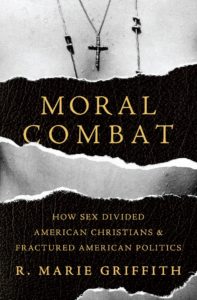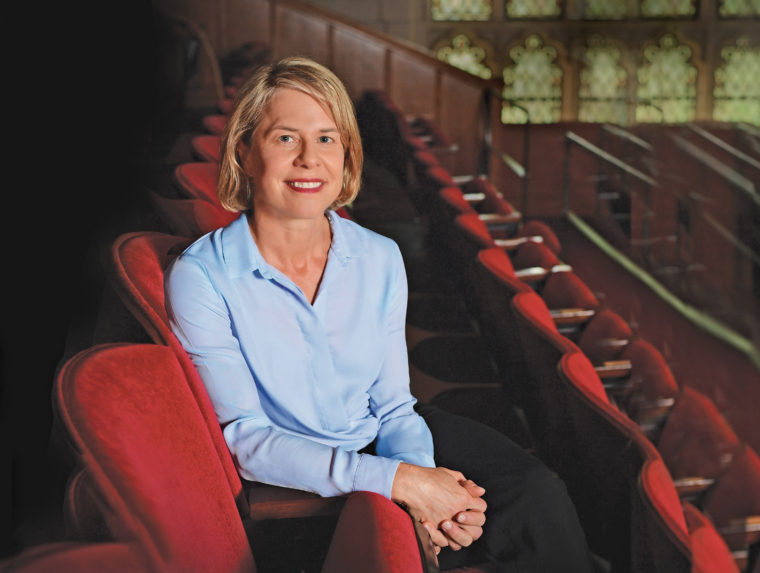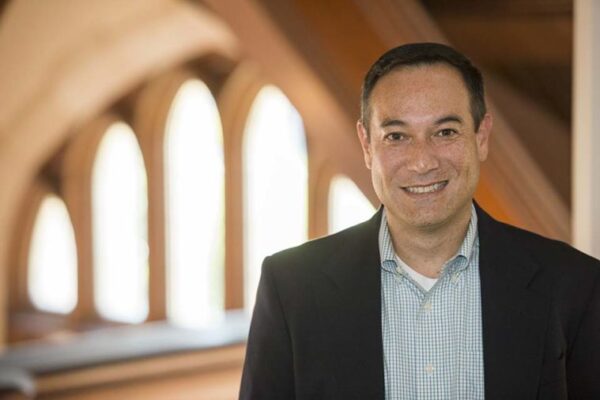Europeans must roll their eyes, watching their adolescent outpost get so worked up about sex. First it was women’s suffrage — would voting destroy a woman’s uterus? — and then the evils of contraception. Movies were censored for the sake of a carefully defined “decency.” Interracial passion was forbidden, because the Bible was read as urging “white purity.” People campaigned against sex education in the schools, chose candidates solely by their stance on abortion, opposed same-sex marriage as a danger to the American way.
Why is it so often sex — the act, the orientation, the attendant gender roles, the reproductive consequences — that dominates and divides our political arena?
As the director of the university’s John C. Danforth Center on Religion & Politics, the co-editor of Religion and Politics in the Contemporary United States, and a frequent commenter on national religious and political issues, R. Marie Griffith was well-positioned to answer that question in her new book, Moral Combat: How Sex Divided American Christians and Fractured American Politics. The topic has been with her since her Southern Baptist childhood in Chattanooga, Tennessee, where she witnessed deep differences among friends and family she adored.
Asked to summarize, in a single sentence, why sexual issues are so supercharged in this country, Griffith says, “A lot of it is a reaction to women and women’s rights, which are often tied to sexual behavior, both in people’s minds and in reality.”
 Don’t blame the Puritans
Don’t blame the Puritans
In the U.S., issues of gender, sex and sexuality have tended to clump together, with acknowledgements of equal rights advocated in terms of compassion and justice by progressives and seen as godless threats to the moral order by religious conservatives. In her book, Griffith, the John C. Danforth Distinguished Professor, shows us one tragedy after another, from 9/11 to Sandy Hook, being blamed on “the pagans, and the abortionists, and the feminists, and the gays and lesbians … all of whom have tried to secularize America.”
Such an extreme stance triggered opposition within Christianity, and progressives and conservatives began to line up on opposite sides of the sanctuary. Each group tried to pull the teachings of Christianity to its side — and set the nation’s political agenda with each tug.
Could this history have unfolded in, say, France? Or Thailand?
“People ask me that question a lot,” Griffith says. “It’s not necessarily that I think the conflict between religion and sex is unique to American society. But I do think the way it has unfolded in the U.S. is pretty specific to our own religious and political history.”
Ah, the Puritans — but, no, Griffith is shaking her head. “Yes, it’s the root of our word ‘puritanical,’ and the Puritans were very strict about where and when sex should take place,” she says, “but they weren’t anti-sex. We really overread that. I think the Victorians had more to do with it, but of course it’s much more complicated than that.”
On purity and perdition
Griffith’s book begins in the Victorian era, with the women’s suffrage movement. Today, we assume women’s right to vote was a long battle that finally ended in victory — but it didn’t actually end. All that anti-suffrage fervor broke out again in the next debate over contraception as the end of the American family. Liberal Protestants deliberately distanced themselves from official Catholic teachings (just as they’d later distance themselves from the organized religious right of the 1990s).
Next, in the fight over segregation, race, sex and politics swirled together: “For years, there was no topic more forbidden, no issue more explosive, than interracial sex,” Griffith writes. Segregation was God’s will, some believed, because the “purity” of the white race had to be preserved.
How did people call themselves Christians while branding African-Americans as bestial, subhuman and soulless? “It’s horrible to confront, but they believed, and taught their children to believe, that this was God’s plan,” Griffith says simply. Ignore race mixing, and you condemned yourself and the rest of the nation to moral depravity and perdition. “The stakes were really that high, in their minds.”
She continues to offer historical perspective, reminding readers that “before the late-nineteenth century, the practice of intentionally terminating a human pregnancy was quite common and almost wholly unregulated across the United States,” with abortifacient patent medicines advertised even in religious papers. Only in the late 1800s did newspapers begin printing lurid stories of botched abortions, as physicians pronounced the procedure medically hazardous and perhaps morally wrong as well.
By the mid-20th century, we had Hollywood’s decency codes — with their emphasis on the sanctity of marriage and the home — and Alfred Kinsey’s shocking reports on the truth of sexual behavior. Kinsey didn’t hesitate to blame religion for the “shame, remorse, despair, desperation and attempted suicide” of women who broke its rules. Slowly, those norms were easing (though in 1953, the Rev. Billy Graham thanked God “we have millions of women who still know how to blush”). When Mary Steichen Calderone, MD, MPH, pushed for science-based sex education in the 1960s, she wondered aloud, “How could something so natural and also so good, so sacred and so joyous be a force for evil and division in the world?”
Us, too?
Griffith ends her chronicle pretty hopelessly: By the time same-sex marriage was legalized, American Christianity “seemed to have split into two oppo-sitional, mutually hostile faiths.” Trump’s election and #MeToo haven’t lessened that divide. “It would be naïve to imagine that Americans in this standoff can return to any consensus regarding sex and gender,” Griffith writes, “and impossible to imagine what such a consensus could possibly look like.”
She traces our sharpest divisions to fear: a fear of women, or of those with a different skin color or ethnic background, or of the decline of America itself. But what she still can’t understand is “why women’s equality is so threatening. We couldn’t even get an equal rights amendment passed! Such simple things, over and over again, fail.”
As she told Terry Gross on NPR’s Fresh Air, there’s long been a suspicion that “if women get to choose how they live their lives, they’re going to choose against marriage, childbearing, the family.”
That prospect so terrified us that gender and sex became the ultimate wedge issues. They split American Christianity into factions, and they divided the nation.



